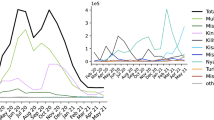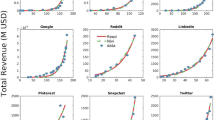Abstract
From decentralized banking systems to digital community currencies, the way humans perceive and use money is changing1,2,3, thus creating novel opportunities for solving important economic and social problems. Here, we study Sardex, a fast-growing community currency in Sardinia (involving 1,477 businesses arrayed in a network with 48,170 transactions) using network analysis to shed light on its operation. Based on our experience with its day-to-day operations, we propose performance metrics tailored for Sardex but also to similar economic systems, introduce criteria for identifying prominent economic actors and investigate the interplay between network structure and economic robustness. Leveraging new methods for quantifying network ‘cyclic density’ and ‘k-cycle centrality,’ we show that geodesic transaction cycles, where money flows in a circle through the network, are prevalent and that certain nodes have a pivotal role in them. We analyse the transactions within cycles and find that the economic turnover of the involved firms is higher, and that excessive currency and debt accumulations are lower. We also measure a similar, but secondary, effect for nodes and edges that serve as intermediaries to many transactions. These metrics are strong indicators of the success of such mutual credit systems at individual and collective levels.
This is a preview of subscription content, access via your institution
Access options
Access Nature and 54 other Nature Portfolio journals
Get Nature+, our best-value online-access subscription
$29.99 / 30 days
cancel any time
Subscribe to this journal
Receive 12 digital issues and online access to articles
$119.00 per year
only $9.92 per issue
Buy this article
- Purchase on Springer Link
- Instant access to full article PDF
Prices may be subject to local taxes which are calculated during checkout




Similar content being viewed by others
Data availability
The data that support the findings of this study are available from the corresponding author upon reasonable request, subject to approval by Sardex Spa and based on the confidentiality agreement of Sardex Spa with its clients.
References
Satoshi, N. Bitcoin: a peer-to-peer electronic cash system. bitcoin https://bitcoin.org/en/bitcoin-paper (2008).
Suri, T., Jack, W. & Stoker, T. M. Documenting the birth of a financial economy. Proc. Natl Acad. Sci. USA 109, 10257–10262 (2012).
Seyfang, G. & Longhurst, N. Growing green money? Mapping community currencies for sustainable development. Ecol. Econ. 86, 65–77 (2013).
Sundararajan, A. The Sharing Economy (MIT Press, Cambridge, 2016).
The Sardex factor. Financial Times Magazine (18 September 2015); http://www.ft.com/intl/cms/s/2/cf875d9a-5be6-11e5-a28b-50226830d644.html
Littera, G., Sartori, L., Dini, P. & Antoniadis, P. From an idea to a scalable working model: merging economic benefits with social values in Sardex. Int. J. Community Currency Res. 21, 6–21 (2017).
Watts, J. & Strogatz, S. H. Collective dynamics of ‘small-world’ networks. Nature 393, 440–442 (1998).
Barabasi, A. L. & Albert, R. Emergence of scaling in random networks. Science 286, 509–512 (1999).
Erdos, P. & Renyi, A. On the evolution of random graphs. Publ. Math. Inst. Hung. Acad. Sci. 5, 17–60 (1960).
Butts, C. T. Cycle Census Statistics for Exponential Random Graph Models (Institute for Mathematical Behavioral Sciences, UC Irvine, 2006); https://escholarship.org/uc/item/4719h8d2
Ma’ayan, A. et al. Ordered cyclic motifs contribute to dynamic stability in biological and engineered networks. Proc. Natl Acad. Sci. USA 105, 19235–19240 (2008).
Carvalho, V. M., Nirei, M., Saito, Y. U. & Tahbaz-Salehi, A. Supply Chain Disruptions: Evidence from the Great East Japan Earthquake Working Paper No. 2017-01 (Becker Friedman Institute for Research in Economics, 2017).
Bianconi, G., Gulbahce, N. & Motter, A. E. Local structure of directed networks. Phys. Rev. Lett. 100, 11870 (2008).
Opsahl, T., Colizza, V., Panzarasa, P. & Ramasco, J. J. Prominence and control: the weighted rich-club effect. Phys. Rev. Lett. 101, 168702 (2008).
Milo, R. et al. Network motifs: simple building blocks of complex networks. Science 298, 824–827 (2002).
Freeman, L. C. Centrality in social networks conceptual clarification. Soc. Networks 1, 215–239 (1978).
Snijders, T. A. B. & Kenny, D. A. The social relations model for family data: a multilevel approach. Pers. Relat. 6, 471–486 (1999).
Banerjee, A., Chandrasekhar, A. G., Duflo, E. & Jackson, M. O. The diffusion of microfinance. Science 341, 1236498 (2013).
Guyer, J. J. Soft currencies, cash economies, new monies: past and present. Proc. Natl Acad. Sci. USA 109, 2214–2221 (2012).
Simmel, G. The Philosophy of Money (Routledge, Cambridge, 2011).
Lazer, D. et al. Life in the network: the coming age of computational social science. Science 323, 721–723 (2009).
Brockmann, D., Hufnagel, L. & Geisel, T. The scaling laws of human travel. Nature 439, 462–465 (2006).
Nishi, A., Shirado, H., Rand, D. & Christakis, N. A. Inequality and visibility of wealth in experimental social networks. Nature 526, 426–429 (2015).
Nishi, A., Shirado, H. & Christakis, N. A. Intermediate levels of social fluidity amplify economic growth and mitigate economic inequality in experimental social networks. Sociol. Sci. 2, 544–557 (2015).
Rand, D. G., Nowak, M., Fowler, J. H. & Christakis, N. A. Static network structure can stabilize human cooperation. Proc. Natl Acad. Sci. USA 111, 17093–17098 (2014).
Fagiolo, G., Reyes, J. & Schiavo, S. On the topological properties of the world trade web: a weighted network analysis. Phys. A 387, 3868–3873 (2008).
Soramaki, K., Bech, M. L., Arnold, J., Glass, R. J. & Beyeler, W. E. The topology of interbank payment flows. Phys. A 379, 317–333 (2007).
Abraham, D. J., Blum, A. & Sandholm, T. Clearing algorithms for barter exchange markets: enabling nationwide kidney exchanges. In Proc. 8th ACM Electronic Commerce 295–304 (ACM, 2007).
Bardoscia, M., Battiston, S., Caccioli, F. & Caldarelli, G. Pathways towards instability in financial networks. Nat. Commun. 8, 14416 (2017).
Kiyotaki, N. & Moore, J. Evil is the root of all money. Am. Econ. Rev. 92, 62–66 (2002).
Camera, G., Casari, M. & Bigoni, M. Money and trust among strangers. Proc. Natl Acad. Sci. USA 110, 14889–14893 (2013).
Lu, Y. Y., Slotine, J. J. & Barabasi, A. L. Control centrality and hierarchical structure in complex networks. PLoS ONE 7, e44459 (2012).
Johnson, D. B. Finding all the elementary circuits of a directed graph. SIAM J. Comput. 4, 77–84 (1975).
Acknowledgements
We thank D. G. Alvarez, F. Fu, J. Horton and A. Oswald for helpful comments. Support for this research was provided by a grant from the Robert Wood Johnson Foundation and the Star Family Foundation. Also, G.I. acknowledges that this publication has emanated from research supported in part by a research grant from Science Foundation Ireland under grant 16/IA/4610; and E.M.A. acknowledges the support by the National Science Foundation under grant IIS-1409177 and by the Office of Naval Research under grants YIP N00014-14-1-0485 and N00014-17-1-2131 to E.M.A. The funders had no role in study design, data collection and analysis, decision to publish or preparation of the manuscript.
Author information
Authors and Affiliations
Contributions
G.I., Y.C., L.T. and N.A.C. designed the project. G.I. and G.L. prepared the data. G.I. and Y.C. performed the statistical analyses. G.I., Y.C., E.M.A., L.T. and N.A.C. analysed the findings. G.I., Y.C., E.M.A., G.L., L.T. and N.A.C. wrote the manuscript.
Corresponding author
Ethics declarations
Competing Interests
G.L. is one of the founders and currently an employee of Sardex Spa.
Additional information
Publisher’s note: Springer Nature remains neutral with regard to jurisdictional claims in published maps and institutional affiliations.
Supplementary information
Supplementary Information
Supplementary Notes 1–4, Supplementary Tables 1–23, Supplementary Figures 1–14, Supplementary References
Supplementary Software
Supplementary Code 1–7
Supplementary Video 1
Edges creation in Sassari during 2013. The nodes represent businesses that are located in Sassari, and the edges depict their trading relationships (one or more transactions). The video presents the edges in a temporal sequence
Rights and permissions
About this article
Cite this article
Iosifidis, G., Charette, Y., Airoldi, E.M. et al. Cyclic motifs in the Sardex monetary network. Nat Hum Behav 2, 822–829 (2018). https://doi.org/10.1038/s41562-018-0450-0
Received:
Accepted:
Published:
Issue Date:
DOI: https://doi.org/10.1038/s41562-018-0450-0
This article is cited by
-
Circulation of a digital community currency
Scientific Reports (2023)
-
Markets and the Future of the Circular Economy
Circular Economy and Sustainability (2023)
-
Sarafu Community Inclusion Currency 2020–2021
Scientific Data (2022)
-
Resource sharing in technologically defined social networks
Nature Communications (2019)



